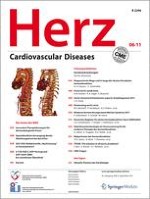Erschienen in:

01.09.2011 | Schwerpunkt/CME
Malperfusion bei Aortendissektion
Diagnostische Probleme und therapeutische Möglichkeiten
verfasst von:
Dr. R.A. Jánosi, D. Böse, T. Konorza, H. Eggebrecht, K. Tsagakis, H. Jakob, R. Erbel
Erschienen in:
Herz
|
Ausgabe 6/2011
Einloggen, um Zugang zu erhalten
Zusammenfassung
Die Malperfusion der Aorta und ihrer Seitenäste ist eine häufige Komplikation der Aortendissektion. Die durch die akute Aortendissektion drohende Minderperfusion von Organen ist eine der Hauptursachen für die hohe Mortalität und Morbidität bei diesen Patienten. Daher sind eine schnelle Diagnose, die Identifizierung der ischämiegefährdeten Organe und die umgehende Einleitung einer Therapie zur Reperfusion erforderlich, bevor es zu bleibenden Endorganschäden kommt. Erschwert wird dies durch die häufig initial nur diskret bestehenden Symptome, die durch eine verzögerte Therapie letztendlich fatal enden können.
Die Abdeckung des primären Intimaeinrisses durch einen endovaskulären Stent-Graft führt nicht bei allen Patienten auch zu einer Aufhebung der viszeralen Malperfusion. Zur Reperfusion sind verschiedene Methoden wie die Fenestrierung der Dissektionsmembran, die endovaskuläre aortale Implantation von nichtgecoverten Stent-Grafts oder das direkte perkutane Stenting der aortalen Seitenäste entwickelt worden.
Die direkte endovaskuläre Behandlung der Malperfusion bietet eine vielversprechende Alternative zur chirurgischen Rekonstruktion, da sie schnell zur Verfügung steht, weniger invasiv ist und ein geringeres Risiko für den Patienten beinhaltet.